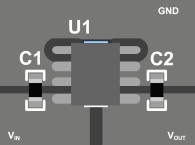
Let us first clarify what we want to achieve. In signal level audio, what we would like is that the output voltage of a source is not influenced by the next connected receiver. The accepted term is “maximum voltage transfer,” which should speak for itself. (That is not the only possibility; in RF technology, for example, often maximum power transfer is the goal).
We can model the interface between a source and a receiver as in the figure below. (We assume the Rout and Rin are resistive but the same reasoning will hold for complex impedances that have a capacitive and/or inductive component). The source has a Vout and a Rout, the output resistance. If there is no receiver, there is no load current required from the source, thus there is no voltage drop across Rout and Vsig is the same as Vout.
Now we connect the receiver, which has a Rin, and current flows through Rout and Rin to ground, and this causes a voltage drop across Rout. That means that Vsig is now lower than Vout: We are losing some output voltage. That is a disadvantage; not only does it lower the gain, but the extra current drain from the source might increase distortion (although it may be minimal).
Now to our goal of maximum voltage (or signal) transfer: It is obvious that the best situation is when Rin is highest (minimizing the current drain), and when Rout is lowest (minimizing voltage drop loss). Back to our example given at the start. The maximum load for the preamp was specified as 10kΩ; the amp has a 20kΩ input resistance so that condition is met. We do lose a bit of signal: Rout is 1/201 part of the total resistance the signal flows through, so we have 1/201 of the signal across Rout, which is a very small loss. To put it in perspective: if the unloaded Vout was 1.000V, it will drop to 0.995V when we connect the amp. Nothing to lose any sleep over.

To Wrap Up
When interconnecting a source to a receiver, make sure that the source is not loaded with a lower resistance than the lowest specified. If you have a choice, go with lowest possible source Rout and highest possible receiver Rin. aX







